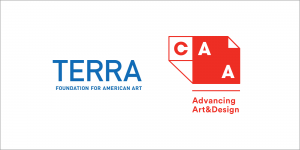CAA News Today
Ellen Levy, Author of Chapter 8: Art in an Academic Setting
posted by CAA — Nov 29, 2021
As part of CAA’s 10-year anniversary celebration of its publication The Eye, the Hand, the Mind: 100 Years of the College Art Association, chapter authors reflect on their contributions and how their impressions of the field have changed. Our second video in the series features Ellen Levy, who wrote Chapter 8, “Art in an Academic Setting: Contemporary CAA Exhibitions.”
Ellen K. Levy, PhD, is a multimedia artist and writer known for exploring art, science and technology interrelationships since the mid-1980s. Levy highlights their importance through exhibitions, educational programs, publications and curatorial opportunities. Her graduate studies were at the School of the Museum of Fine Arts, Boston following a B.A. from Mount Holyoke College in Zoology. She was President of the College Art Association (2004-2006) before earning her doctorate (2012) from the University of Plymouth (UK) on the art and neuroscience of attention. She then was Special Advisor on the Arts and Sciences at the Institute for Doctoral Studies in the Visual Arts. She was a Distinguished Visiting Fellow in Arts and Sciences at Skidmore College (1999) and taught many transdisciplinary classes and workshops (e.g., the New School, Cooper Union, Brooklyn College, Banff). She was recipient of an AICA award and an arts commission from NASA following a solo exhibition at the National Academy of Sciences (NAS) (1985).
She has exhibited her art internationally and in such landmark exhibitions as Weather Report (Boulder Museum, cur Lucy Lippard) and Gregor Mendel: Planting the Seeds of Genetics (Field Museum, Chicago, adv. Martin Kemp). Levy has published widely on art and complex systems. With Berta Sichel, she guest edited and contributed to CAA’s special issue of Art Journal (spring 1996), likely the first widely distributed academic publication on contemporary art and the genetic code. With Charissa Terranova, she is co-editor of D’Arcy Wentworth Thompson’s Generative Influences in Art, Design: From Forces to Forms (2021, Bloomsbury Press). Levy has also curated a related exhibition for Pratt Manhattan’s gallery. Levy and Barbara Larson co-edit the “art and science since 1750” book series of Routledge Press. Levy and Patricia Olynyk co-direct the NY LASER program, a central initiative of Leonardo/ISAST. She was twice an invited participant in Watermill’s Art and Consciousness Workshop, led by stage director and playwright, Robert Wilson.
Karen Leader, Author of Chapter 12: Advocacy
posted by CAA — Nov 15, 2021
As part of CAA’s 10-year anniversary celebration of its publication The Eye, the Hand, the Mind: 100 Years of the College Art Association, chapter authors reflect on their contributions and how their impressions of the field have changed. Our first video in the series features Karen J. Leader, who wrote Chapter 12, “CAA Advocacy: The Nexus of Art and Politics.”
Karen J. Leader is Associate Professor of Art History and Faculty Associate in the Center for Women, Gender and Sexuality Studies at Florida Atlantic University. She received her BA from the University of California, Berkeley and her MA and Ph.D. at the Institute of Fine Arts, New York University. Her areas of interest include art and popular culture in the 19th-21st centuries, feminist theory and practice, and the history and future of the discipline of art history, the humanities, and higher education. She has published on the artist Gustave Courbet, representations of women in popular culture, and 21st-century tattoo culture. She directs the Barb Schmidt Fellowship: Cultivating Community Involvement, Activism and Social Change, and currently chairs the Services to Historians of Visual Arts Committee (SHVAC) at CAA.You can follow her on Instagram and Twitter @proftinkerbell.
Announcing the CAA 2022 Distinguished Scholar
posted by CAA — Oct 26, 2021
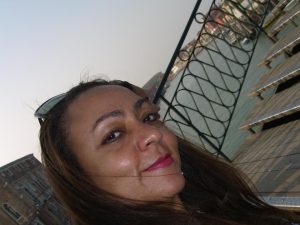
Kirsten Pai Buick
We’re delighted to announce the Distinguished Scholar session at the 110th CAA Annual Conference will honor Kirsten Pai Buick. This session will highlight her career and provide an opportunity for dialogue between and among colleagues. It will be held virtually during the 110th Annual Conference on February 17, 2022.
Established in 2001, the Distinguished Scholar Session illuminates and celebrates the contributions of senior art historians. The Annual Conference Committee identifies the distinguished scholar each year and each session typically brings together the distinguished scholar and a group of colleagues. The honoree’s involvement is fundamental to the series as a way of demonstrating a living tradition that gives voice to the continuities and ruptures that have shaped art-historical scholarship from the twentieth century into the new millennium.
Access to this program requires registration and is included with an All Access registration. Recordings will be accessible to registrants after the event. Register here.
“I identify as a scholar of the visual and material culture of the first British Empire, and the British diaspora in the US, Caribbean, and India. My teaching encompasses topics such as surveys of British Colonial and U.S. Art, American Landscape representation, African American Art, Pro- and Anti-Abolitionist Images in the Atlantic World; and seminars such as Photographing Jim Crow, 1890-1965, Patronizing Women: Taste and Collecting in the 19th and 20th Centuries, and The Victorian Nude: Representing Women, Men, Intersex, and Children. My research and teaching interests encompass histories of science, medicine, religion, as well as monuments, and the use of public space. Increasingly, I am interested in the racialization of mobility—what I characterize as critical mobility studies. I publish primarily in the realm of the history of African American art and its roots in US cultural formations. My first book, “Child of the Fire: Mary Edmonia Lewis and the Problem of Art History’s Black and Indian Subject,” is a good example of how I wed my teaching and publication imperatives together with my challenge to art history and visual studies to be more and to do better. Ultimately, teaching is my passion; and I tell my students that job # 1 is surviving the damage, and job # 2 is to never concede the center.”
Kirsten Pai Buick is a professor of art history at the University of New Mexico. She received her Ph.D. in art history from the University of Michigan and was a SAAM Predoctoral Fellow and a Charles Gaius Bolin Fellow at Williams College. Buick is a recipient of the David C. Driskell Prize for African American Art and has published extensively on African American art, including her book Child of the Fire: Mary Edmonia Lewis and the Problem of Art History’s Black and Indian Subject (Duke Univ. Press, 2010). Her second book, In Authenticity: “Kara Walker” and the Eidetics of Racism, is in progress.
Affiliated Society News: October
posted by CAA — Oct 18, 2021
Association of Historians of Nineteenth-Century Art) (AHNCA)
Announcements
AHNCA announces the winners of their Best Paper Prize at their Graduate Symposium. The Eighteenth Annual Graduate Student Symposium in Nineteenth-Century Art, co-sponsored by the Association of Historians of Nineteenth-Century Art (AHNCA) and the Dahesh Museum of Art was held virtually on September 25–26, 2021. Ten participants, representing future directions for nineteenth-century art history, presented their dissertation research. After prolonged deliberation because of the uniform high quality of the presentations, the jury awarded two Dahesh Prizes of $1000 each, funded by the Mervat Zahid Cultural Foundation, to Lieske Huits of the University of Cambridge and the Victoria & Albert Museum, and Sean Kramer of the University of Michigan.

Events
October 20, 2021, 7pm EDT – Upcoming Virtual Salon: The Art Market in the Nineteenth Century
Please join AHNCA on Wednesday, October 20th, at 7PM EDT for their October Virtual Salon on The Art Market in the Nineteenth Century. This series of online events is co-sponsored by the Association of Historians of Nineteenth-Century Art (AHNCA) and the Dahesh Museum of Art.
For this event, AHNCA will host three specialists, Véronique Chagnon-Burke, Anne Helmreich, and Simon Kell, who will discuss this increasingly important area of nineteenth-century studies. Their discussion will be followed by a Q&A and then a break-out room where attendees can socialize informally.
The event is free and open to the public, but registration is required. Register here.
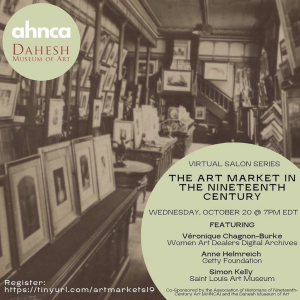
Mid-America College Art Association (MACAA)
Opportunities
Call for art submissions: MACAA Members Virtual Exhibition
MACAA invites its members to submit works of art for consideration to the Members Virtual Exhibition. This exhibition is in coordination with the 2022 Mid-America College Art Association
(MACAA) Virtual Conference, titled “Defining the Undefined: Art, Education, Technology and the Mapping of Ourselves,” hosted by Slippery Rock University of Pennsylvania. The call is open to all mediums and themes. This exhibition, hosted by MACAA via a virtual gallery, is an opportunity to display the incredible work made by MACAA members.
For more information on submission visit this link. Deadline is December 1, 2021.
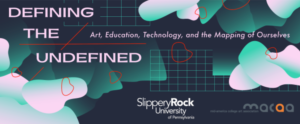
Bibliographical Society of America (BSA)
Events
October 21, 2021, 7pm EDT – Virtual Event: Bluestockings Bookstore: Empowering Queer and Activist Communities
Founded in 1999, Bluestockings Bookstore has served for many years as a cultural hub, activist network, and vibrant community space on the Lower East Side of Manhattan. Entirely all-volunteer run, there are 80+ volunteers, a rotating weekly schedule, and a worker’s collective at the decision-making core. Home to over 300 events a year, Bluestockings offers poetry open-mics, letter writing to prisoners, zine-making workshops, book launches, reading clubs. Panelists Malav Kanuga, Emiliano Lemus, and Joan Dark will share from their personal experiences as former and current members of the Bluestockings collective, offering an in-depth exploration of the space and its pivotal role for queer, transgender, and gender non-conforming individuals.
Register for the event here.

November 1, 2021, 3pm EDT – Collecting, Knowledge, and Power: Perspectives from Latin America
December 9, 2021, 3pm EDT – Collecting and Preserving Colonial Latin America Materials Today: A Roundtable Discussion
The Bibliographic Society of America’s fall series explores the hemispheric histories and contemporary dynamics of collecting and preserving Latin American library and archival materials. Featuring scholars and library and archive professionals based in Latin America and the U.S., the series aims to promote dialogue among scholars and practitioners while confronting ways in which power dynamics have shaped and continue to shape collecting and stewardship practices today.
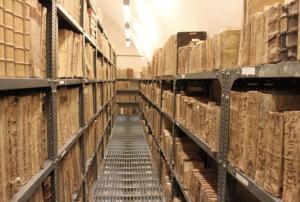
To view past virtual events produced by the Bibliographic Society of America, visit their YouTube page.
Committee on Women in the Arts (CWA) Picks: September
posted by CAA — Sep 26, 2021
The September Picks from the Committee on Women in the Arts highlights a selection of events, exhibitions, and calls for work that includes feminist and womxn artists, and addresses issues about reproductive rights and the female body, equal access to education, and previously under-recognized contributions from womxn artists to the visual arts.
Carmen Winant: The Making and Unmaking of the World
September 18, 2021 – November 27, 2021
Carmen Winant’s work is engaged with the politics, value, and meaning of caretaking and labor traditionally taken on by women. The Making and Unmaking of the World includes nine mobiles, eight collages, and a large-scale, site-specific installation entitled The Actual World (2021). These works combine photographic materials that Winant has collected from instructional books about craft from the 1970s. Both her approach to making these pieces and the source material itself challenge the categorization of fine art vs. craft.
GAIA FUGAZZA: VIRGINITY IS NOT A CONTRACEPTIVE
September 13, 2021 – October 22, 2021
Gaia Fugazza’s Virginity Is Not a Contraceptive includes several mixed-media pieces that reference the female body and fertility juxtaposed with imagery of the cosmos and the natural world. Fugazza’s work is layered and carved, marked by the artist’s hand, and often incorporates natural materials such as beeswax and animal skin. The artist takes great care to reveal and conceal certain aspects of each composition, referencing the complicated and multifaceted nature of identity and the interconnected nature of life.
For the Record: Celebrating Art by Women
continues through October 3, 2021
For the Record: Celebrating Art by Women is made up of pieces from the Norton Museum of Art’s collection that specifically reference the role of women’s contributions in the visual arts. The exhibit includes painting, sculpture, works on paper, photography, and video from both 20th and 21st-century artists and emphasizes their varied and diverse practices. The exhibit also encourages viewers to consider gender equity both within and outside of the art world.
Hair Stories
July 17, 2021 - October 31, 2021
Cushing & Morris Galleries
Hair Stories brings together artists whose work centers around hair as a subject or material. The exhibit frames the political, cultural, and gendered implications of hair and offers a more nuanced understanding of its role in shaping our understanding of ourselves and others. Featured artists include Eunice Adorno, Melanie Bilenker, Tara Bogart, María Magdalena Campos-Pons, Sonya Clark, Sean M. Johnson, Nneka Kai, Vivian Keulards, Wangui Maina, Ana Mendieta, Patricia Miranda, Zanele Muholi, J.D. ‘Okhai Ojeikere, Rachel Portesi, Shahzia Sikander, Lorna Simpson, Gu Wenda, Nafis M. White, Anne Wilson, and D.M. Witman.
Any Distance Between Us
July 17, 2021 – March 13, 2022
Any distance between us is curated by artist-writer Stephen Truax (RISD BFA 2007, Painting) in collaboration with Dominic Molon, the Richard Brown Baker Curator of Contemporary Art at RISD Museum and focuses on works from the museum’s collection that explore the importance of intimate relationships. The exhibit is made up of works by 25 artists who identify as Queer and of color including, Louis Fratino, Aaron Gilbert, Doron Langberg, Deana Lawson, Catherine Opie, Jack Pierson, Elle Pérez, and Salman Toor.
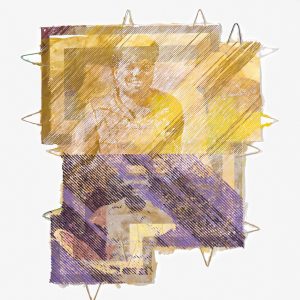
Tomashi Jackson, detail from Brown II, 2021. Image courtesy of the artist and the Tilton Gallery
Tomashi Jackson: Brown II
September 20, 2021–January 15, 2022
Tomashi Jackson’s Brown II, commissioned by the Harvard Radcliffe Institute, explores the landmark Brown v. Board of Education of Topeka Supreme Court decision. Working with a research team of students Jackson interviewed experts and culled the Schlesinger Library archives to inform her practice and visual this historic moment.
CWA Picks: August 2021
posted by CAA — Aug 03, 2021
The August “Picks” from the Committee on Women in the Arts respond to the danger and uncertainty that characterizes the contemporary moment and explore how gender figures into the possibility of imagining new forms of collectivity.
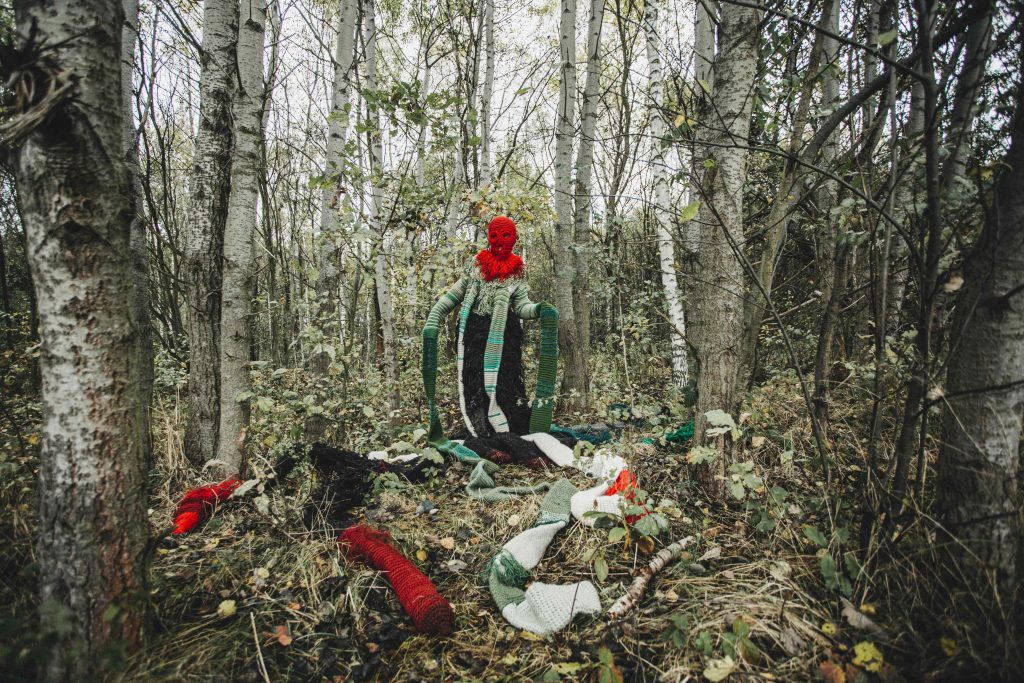
Malgorzata Markiewicz, “Medusa: Sensing-With and Thinking-With the World,” 2021. Print on textile. Photo by Grzesiek Mart
Mona Hatoum
April 16 – September 12, 2021
Institut Valencià d’Art Moderne
Mona Hatoum received the Institut Valencià d’Art Moderne’s Julio González prize in 2020, and this exhibition is a tribute to the influential body of work she has created over the last two decades. Across her installations, sculptures, drawings, and textiles, Hatoum’s investment in materializing spatial concepts as instruments of power asserts itself with a poetic and severe consistency. This spatial refrain emerges from the histories she inherits as an Arab woman, but Hatoum is also committed to showing that oppression can be mapped across the globe. Empty and haunted, ephemeral and permanent, each of Hatoum’s pieces creates an aperture for seeing and sensing the pervasive threat of vulnerability that cannot be cordoned off with neat geographical boundaries.
Double Trouble
July 8 – September 21, 2021
Institute of Contemporary Art of Maine College of Art
The double has often meant trouble for women, as it can encapsulate an assembly-line definition of woman and a Stepford-wife loss of control. This exhibition, however, features the work of five artists who explore the double as a resource for upending habitual definitions of the self without indulging in the fantasy that one can leave historical patterns behind. Creating echoes of bright colors and bold graphic forms, the artwork in Double Trouble is immersed in Pop-like patterns–wallpaper is a recurring motif–as if to watch for the differences that slip free from repetitions.
Malgorzata Markiewicz: Medusa: Sensing-with and thinking-with the world
July 15 – September 30, 2021
Triangle, Riverside, Illinois
Malgorzata Markiewicz’s Medusa makes the production of textiles a form of feminist world-making. Slowly, persistently, intentionally, over seven months of the Covid-19 health emergency, Medusa’s crocheted body emerged, spreading with its fifty-feet long tentacles into the space, first from Markiewicz’s home in Kraków, Poland, and then into her studio. Markiewicz made Medusa with three double-warp fabrics specific to Podlasie, a region in the northeast of Poland. The figure of Medusa stands at the center of this exhibition, masked and regal. Her densely textured form also appears in a film, walking across a meadow and through a forest, and in a series of photographs that stage a liberating journey that moves away from the fear, disgust, and shame traditionally associated with Medusa and toward a new feminist way of sensing-with and thinking-with with the world.
New Time: Art and Feminisms in the 21st Century
August 28 – January 30, 2022
Berkeley Art Museum Pacific Film Archives
New Time: Art and Feminisms in the 21st Century is a major survey exploring recent feminist practices in contemporary art. Rather than defining feminist art, New Time reveals all that the category can encompass as artists respond to the unfolding of history in the present. Although artworks made since 2000 are the primary focus, the objects and installations on view span several generations, mediums, geographies, and political sensibilities. New affinities emerge—the silhouettes of Kara Walker resonate with the sculpture of Kiki Smith—and convey the heterogeneous, intergenerational, and gender-fluid nature of feminist practices today.
Louise Bourgeois, Freud’s Daughter
May 21, 2021 – September 12, 2021
The Jewish Museum, New York
Louise Bourgeois viewed her artistic practice as a form of psychoanalysis. Rather than relegating that claim to a footnote or a biographical aside, this exhibition makes it central. Freud’s Daughter places Bourgeois’s original psychoanalytic writings, which include dream recordings and process notes, in dialogue with 40 works of art. These texts, many of which have not been seen before, become their own form of artmaking. They attest to Bourgeois’s onerous, often lyrical, and profoundly feminist struggle to loosen the Oedipal confines placed around women’s capacities to imagine and materialize different forms of feeling.
Wangechi Mutu: I Am Speaking, Are You Listening?
May 7 – November 7, 2021
Legion of Honor Museum, San Francisco
Wangechi Mutu’s I Am Speaking, Are You Listening? intervenes in the Legion of Honor’s homage to the classical imaginary of Euro-American culture. Many of her gorgeous sculptures portray earthy hybrid beauties who stand for the vulnerable physicality western culture systemically inflicts on people of African descent. Vibrant, damaged, and thoughtful survivors of colonial extraction, Mutu’s figures rhyme with the museum’s canonical objects but also register the pathologized differences Black bodies are made to bear. The Legion of Honor is known for Auguste Rodin’s The Thinker (1904), which dominates its atrium entrance, and in his field of vision, Mutu has placed bronze sculptures of corpses covered with opaque blankets that suggest a crime scene. Except for the hands with polished nails and the feet decorated with red stilettos that stick out from the edges of the blankets, the bodies are not visible. But the feminized excesses—one of the artist’s prominent themes—evoke other possibilities for thinking that Mutu has begun to create through her dialogue with histories of willed silence.
Eileen Agar: Angel of Anarchy
May 19 – August 29, 2021
Whitechapel Gallery, London
This definitive retrospective of the British-Argentinian artist Eileen Forrester Agar (1899–1991) demonstrates just how much her work absorbed and foresaw the twentieth century’s wide array of aesthetic innovations. Agar was included in the 1936 International Surrealist Exhibition, and her rebellious oeuvre certainly captures its feminist potential, but Angel of Anarchy resists the impulse to identify her work only or primarily through Surrealism. Exhibiting over 150 artworks and newly discovered archival material, Angel of Anarchy captures Agar’s nimble travels through artistic mediums, movements, and hierarchies to better see the bright, undulating landscapes of erotic anarchy she created in their wake.
Pauline Curnier Jardin, Fat to Ashes
April 12 – September 19, 2021
Hamburger Bahnhof, Museum für Gegenwart, Berlin
In 2019, the French artist Pauline Curnier Jardin won the Preis de Nationalgalerie, and the film installation Fat to Ashes lives up to the epic scale that might be associated with such an honor. In the historic halls of the Hamburger Banhof, Jardin has created a large-scale amphitheater with material that looks like pie dough—edible, soft, and supple. Inside the arena is a bright red seating area, and the elevated screen appears amidst draped fabrics of translucent pink. The film interweaves three scenes: the procession of St. Agatha in Sicily, the slaughter of a pig, and the carnival in Cologne. Jardin’s cinematic triptych, with its sensual, tactile visuality, portrays the excess and death swirling around the center of collective existence.
Lynn Hershman Leeson: Twisted
June 30 – October 3, 2021
New Museum of Contemporary Art, New York
Twisted is Lynn Hershman Leeson’s first solo exhibition in New York City and tracks her prescient engagement with technology—its sinister and generative impact on corporeal life. The exhibition displays Leeson’s drawings (many of which have never been seen before) and wax sculptures from the 1960s, and together they express her interest in the body’s porous boundaries and detachable parts. Twisted of course includes Roberta Breitmore (1973–1978), the well-known performance series that exemplifies feminist art’s look into the empty heart of identity. A new multi-media installation, Infinity Engine (2014–present), is also part of Twisted. Commissioned by ZKM Center for Art and Media Karlsruhe, Infinity Engine is a simulacrum of a genetics laboratory that replicates its world of science, technology, and self. “Twisted” is a great title for this exhibition: it evokes a sinister sickness, cords, the strands of a DNA molecule, and collaboration. Working with scientists, Leeson revitalizes the historical connection between art and scientific research, but her primary collaborators have always been viewers. She addresses her audience with her accessible message that technology does not have to cancel out the human, but can actually be part of realizing its ethical potential, and creates generous invitations for a participatory response.
Meet the 2021 Recipients of Terra Foundation for American Art Research Travel Grants
posted by CAA — Jul 19, 2021
We’re delighted to announce fourteen scholars have been awarded Terra Foundation for American Art Research Travel Grants in 2021.
These grants provide support to doctoral, postdoctoral, and senior scholars from both the US and outside the US for research topics dedicated to the art and visual culture of the United States prior to 1980.
International Research Travel Grants for US-based Scholars
Doctoral Scholars
Thomas Busciglio-Ritter, The University of Delaware, “‘The Union of Excellences’: An Atlantic History of Early American Landscape Views (1790–1860)”
Ann Tartsinis, Stanford University, “Modernism in Pieces: Transatlantic Visual Culture Between the Wars”
Postdoctoral & Senior Scholars
Caroline Riley, Boston University, “Thérèse Bonney’s Photography: The Politics of Art, the Body,and War from 1920–1970”
Nadia Sethi, University of Washington, “Alaska Native Cultural Belongings held in Museums in Estonia, Finland and Sweden”
Kay Wells, University of Wisconsin-Milwaukee, “Uncanny Revivals: Designing Early America during the Rise of Fascism”
International Research Travel Grants to the United States
Doctoral Scholars
Max Böhner, Humboldt-Universität zu Berlin, Germany, “Twilight Aesthetics: Queer Visual Culture in the United States Between 1945 and 1969”
Sarah Happersberger, Justus-Liebig-Universität Giessen, Germany, “Connection, Community, Kinship, Network: Women Artists Performing Togetherness in the Long 1970s”
Jacqueline Mabey, University College London, England, “This Must Be the Place: Mapping Artistic Kinship and Economic Change in Downtown New York, 1973–1987”
Ana Gabriela Rodriguez, The Courtauld Institute of Art, England, “Tracing Puerto Rican Graphic Arts: Bridging Workshops and Crossing Borders, 1940s –1970s”
Frances Varley, The Courtauld Institute of Art, England, “Identity, Provincialism and Modernism in the US and Britain from a Comparative Perspective, c. 1870–1914”
Wen Yao, The University of York, England, “A Travelling Surrealist: Mobility and Representation in Stella Snead’s Paintings, Photographs and Collages Made in the US (1940–1980)”
Postdoctoral & Senior Scholars
Dafne Cruz Porchini, Universidad Nacional Autónoma de México, “Jean Charlot: A French Artist in the United States and Mexico (1921–1944)”
Maria Stavrinaki, Université Paris I Panthéon–Sorbonne, France, “‘After History’: Variations on a Theme in the Art and Thought of the 1950s–1960s”
Emily Warner, Independent Scholar, “Abstraction Unframed: Abstract Murals at Midcentury”
Learn more about the Terra Foundation Research Travel Grants
Remembering Rick Asher
posted by CAA — Jul 13, 2021
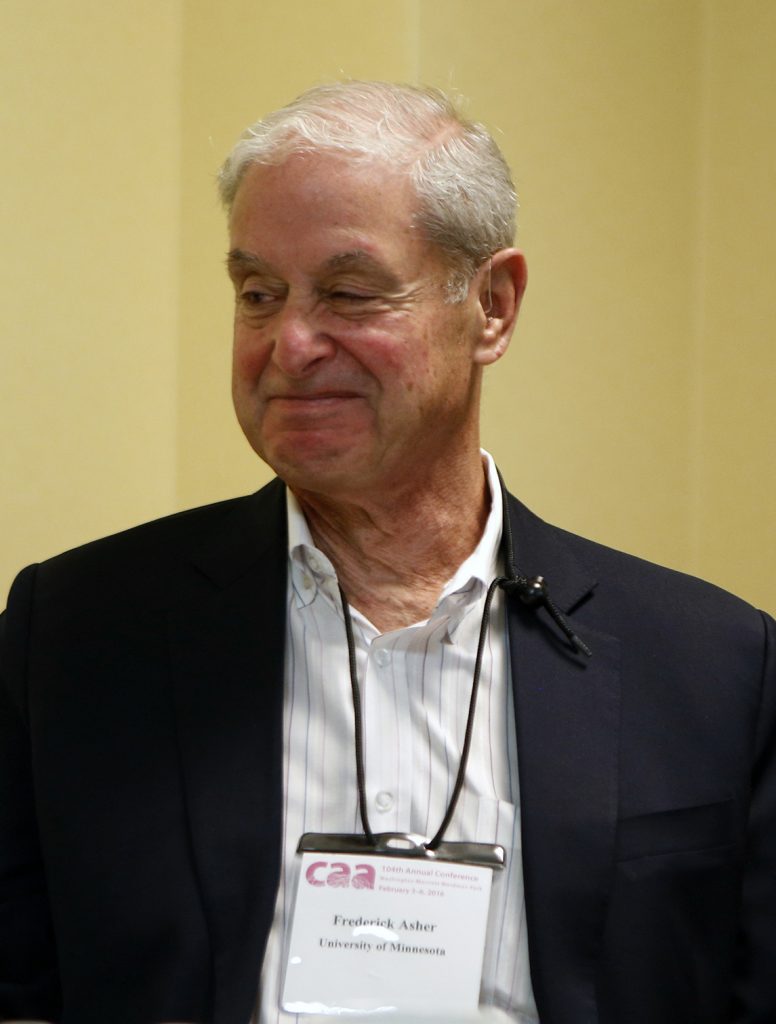
Rick Asher. Photograph by Ben Fractenberg.
Frederick M. Asher, beacon of collegiality and builder of institutions, died on June 26, 2021, having turned 80 just one month earlier. His generosity of spirit guided many scholars through their graduate years and beyond: at the University of Minnesota, where he spent his academic career, and around the world. With Catherine B. Asher, his wife and fellow historian of South Asian art, he led initiatives to document and preserve images of art, archaeological, and architectural objects and sites in India; mentored numerous colleagues and students; and contributed his energies to making academic organizations flourish across the world. He was an early, active member of the American Council for Southern Asian Art (ACSAA); served as president of the American Institute of Indian Studies; and played many roles at CAA, most recently as part of the CAA-Getty International Program where his energies encouraged many of us to reach out across physical and intellectual distances to begin new conversations.
His early research, published in 1980 as The Art of Eastern India, 300–800 (Minnesota), draws connections across the Gupta and Pala eras, thinking deeply about continuities across media—terracotta, bronze, and stone—and across belief systems. His subsequent research led him to study contemporary sculptural practices as a way of understanding the work of unnamed historical sculptors and to a deep engagement with the materiality, crafting, and afterlives of both sculptural objects and the sites where they were worshipped and excavated. His final book, Sarnath: A Critical History of the Place Where Buddhism Began (Getty 2020), published just months before his death, focused on the place where the historical Buddha preached his first sermon, tracing the establishment, excavation, and reimagining of the monastic site from that founding moment to the present. In April, Rick discussed the book with James Cuno for a Getty podcast, giving us a glimpse into his intellectual process and offering many of us a reminder of the rhythms of his class lectures. With his students, Rick always ran toward questions and tantalizing bits of information, wondering at what we don’t know about the past and at the same time marveling at contemporary uses of ancient sculptures and sites. At Sarnath, this meant both the tourists shuttling in from Varanasi with their local guides (guides who almost certainly had met Rick and discussed their mutual love of the site with him) and the international monastic Buddhist communities with pilgrimage centers nearby. Rick cared deeply about his students, and his engaging, dynamic teaching was renowned. He received the University of Minnesota’s Morse-Alumni Undergraduate Teaching Award in 2005–2006, one of his most treasured moments of recognition.
I was incredibly fortunate to visit Sarnath for the first time with Rick and Cathy as part of a trip they organized for the cohort of graduate students in the late 1990s. The trip was exemplary of the Ashers’ generosity and openness—recognizing the hurdles associated with pursuing academic research in India, they sought to pass on their extensive experience by offering us the opportunity to shadow them in their respective projects. Rick had been working with a scientist at the University of Minnesota to ascertain the locations of quarries for various Pala-era (8th–12th century) sculptures by matching stone samples. The project focused on both the materiality and the process of crafting the sculptures—he considered how stone was separated from the earth, how it would have been chosen for a sculpture, and then how it was carefully carved with the detailed iconographies of a Vishnu or a Tara.1 The project’s success relied on his ability to bring people together in a common project: Rick recruited curators and conservators at museums around the world to undertake the delicate process of excising a thin section from the back of these sculptures to compare to the samples he gathered from quarries in Bihar and Bengal. It was this latter piece of the project that he embarked on that summer, taking two of us green graduate students with him into remote areas of Bihar, where we stayed in dak bungalows (remnants of the nineteenth-century postal system) and revisited many of his early research sites from his own graduate days. Rick’s enthusiasm for reconnecting with the people of the region and introducing us to them still resonates with me today, guiding my own fieldwork experiences beyond the inert object to understand the deep interconnections between art, history, and the people who made and continue to interact with the “works of art” we study, works that remain very much alive in the present.
Rick had an incredible gift for open and positive leadership. He hosted ACSAA’s first conference in 1981, and he made sure that the group served as a space of warm, collegial exchange as it grew over the decades. He attended every conference, symposium, workshop, and meeting, seeking out the panels where colleagues and former students were presenting. He would often ask the first question, to draw out commonalities across a diverse panel and also, I came to realize, to facilitate discussion and to give everyone else in the audience time to formulate their own questions. It was primarily at conferences that he would make connections between scholars, a kind of academic matchmaking, if you will. One of the truths of my academic life is that if we have met, Rick probably introduced us. He would stride over, beaming, happy to see you, and then almost immediately say, “there’s someone here you should meet.” Then he would bound off, urging you to follow, to joyfully connect you to a towering senior scholar or newly minted PhD, offering a few choice intellectual threads to solidify the link. Rick understood that the big institutions—CAA prominent among them—only worked because of the dedication of an interconnected group of individuals who recognized their shared commitment to the field. These introductions wove the fabric of these institutions such that when he passed, my email inbox was filled with loving notes and remembrances from colleagues around the world—his colleagues, and also, because of him, my colleagues.
Rick, whose intellectual pursuits focused on the material connections between works of art and people and who cared deeply for makers of objects and sites and the ways in which places and people shaped one another over time, thus continues to connect us even at the moment of his passing. His own post-history has yet to be written, but I have a strong feeling that his energy and presence will be with us at each future academic meeting, in each future encounter. So wonderful to see you! Come, there’s someone here you should meet.
–Rebecca M. Brown, Johns Hopkins University
Meet the Spring 2021 Millard Meiss Publication Fund Grant Recipients
posted by CAA — Jun 24, 2021

Mbanza Kongo (São Salvador), capital of the Kingdom of Kongo, mid-18th century
MEET THE GRANTEES
Twice a year, CAA awards grants through the Millard Meiss Publication Fund to support book-length scholarly manuscripts in the history of art, visual studies, and related subjects that have been accepted by a publisher on their merits, but cannot be published in the most desirable form without a subsidy.
Thanks to the generous bequest of the late Prof. Millard Meiss, CAA began awarding these publishing grants in 1975.
Spring 2021 Grantees
Annette de Stecher, Wendat Women’s Art, McGill-Queen’s University Press
Sylvia Houghteling, The Art of Cloth in Mughal India, Princeton University Press
Pamela Karimi, Alternative Iran: Radical Spatial Strategies in Contemporary Art Practice, Stanford University Press
Meredith Martin and Gillian Weiss, The Sun King at Sea: Maritime Art and Galley Slavery in Louis XIV’s France, Getty Research Institute
Ying-Chen Peng, Artful Subversion: Empress Dowager Cixi’s Image Making in Art, Yale University Press
Yael Rice, Agents of Insight: Artists, Books, and Painting in Mughal South Asia, University of Washington Press
Sarah-Neel Smith, Metrics of Modernity: Art and Development in Postwar Turkey, University of California Press
Bert Winther-Tamaki, Tsuchi: An Environmental History of Contemporary Japanese Art, University of Minnesota Press
Jay Buchanan, Holly Gabelmann, Caroline Giddis, and Clarissa Chevalier: “Collaboration, finding purpose, occupying intermediate space and making noise together!”
posted by Allison Walters — Apr 09, 2021
Jay Buchanan is a theorist, poet, and arts orchestrator.
Holly Gabelmann is an artist, writer, and asker of questions. They are the co-creators of Idiosynchrony, a podcast and collective sonic artwork. www.idiosynchronypodcast.com
Caroline Giddis is a writer, emerging curator, and art historian of the long nineteenth century focusing on intersectional feminism.
Clarissa Chevalier is an interdisciplinary researcher, writer, and art historian specializing in modern and contemporary ecological art.They are the founders and co-editors of Tesserae Press, an online arts publication for emerging creative voices. www.TesseraePress.com



